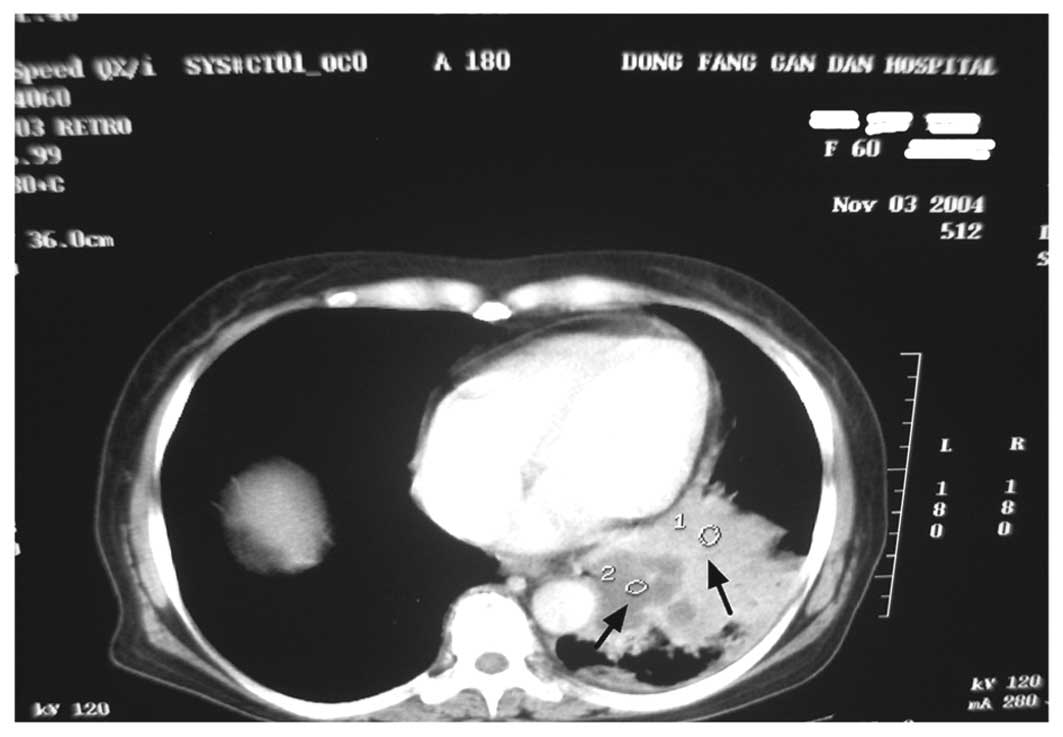Distal bile duct cancers complicated with cholangiobronchopleural fistula after ERCP: A case report
- Authors:
- Changsong Zhang
- Guangshun Yang
- Yang Ling
- Guihua Chen
- Tianbao Zhou
-
View Affiliations
Affiliations: Clinical Oncology Laboratory, Changzhou Tumor Hospital, Medical College of Soochow University, Changzhou, Jiangsu 213002, P.R. China, The Eastern Hepatobiliary Surgery Hospital, The Second Military Medical University, Shanghai 200438, P.R. China, Clinical Oncology Laboratory, Changzhou Tumor Hospital, Medical College of Soochow University, Changzhou, Jiangsu 213002, P.R. China, The Hepatic Surgery Center, The Third Affiliated Hospital, Sun Yat‑Sen University, Guangzhou, Guangdong 510630, P.R. China, The Hepatobiliary Surgery Centre, The Affiliated Ningbo No. 2 Hospital, Ningbo University School of Medicine, Ningbo, Zhejiang 315010, P.R. China
- Published online on: July 10, 2014 https://doi.org/10.3892/ol.2014.2342
-
Pages:
1828-1830
Metrics:
Total
Views: 0 (Spandidos Publications: | PMC Statistics:
)
Metrics:
Total PDF Downloads: 0 (Spandidos Publications: | PMC Statistics:
)
This article is mentioned in:
Abstract
Distal (lower) bile duct cancers arise in the lower half of the biliary tree closer to the small intestine. Biliary disease complicated with cholangiobronchopleural fistula, which may occur in cases of multiple hepatobiliary stones or biliary ascariasis‑associated severe infection, has rarely been reported in the literature, particularly following endoscopic retrograde cholangiopancreatography (ERCP). The present study describes the case of a 60‑year‑old female with distal cholangiocarcinoma complicated with cholangiobronchopleural fistula after ERCP for this rare disease. This complication was likely due to the inability to control retrograde infection following ERCP and, thus, the infection was disseminated. This resulted in mixed infection involving the diaphragm and pleura, and further penetrating the bronchus. The patient was managed with pancreatoduodenectomy and has since remained in good health.
View References
|
1
|
Habib E and Elhadad A: Digestive
complications of gallstones lost during laparoscopic
cholecystectomy. HPB (Oxford). 5:118–122. 2003.
|
|
2
|
Delcò F, Domenighetti G, Kauzlaric D,
Donati D and Mombelli G: Spontaneous biliothorax (thoracobilia)
following cholecystopleural fistula presenting as an acute
respiratory insufficiency. Successful removal of gallstones from
the pleural space. Chest. 106:961–963. 1994.
|
|
3
|
Dasmahapatra HK and Pepper JR:
Bronchopleurobiliary fistula. A complication of intrahepatic
biliary stent migration. Chest. 94:874–875. 1988.
|
|
4
|
Nøjgaard C, Hornum M, Elkjaer M, et al:
Does glyceryl nitrate prevent post-ERCP pancreatitis? A
prospective, randomized, double-blind, placebo-controlled
multicenter trial. Gastrointest Endosc. 69:e31–e37. 2009.
|
|
5
|
Williams EJ, Hamlyn A, Logan RF, Martin D,
Wilkinson ML and Lombard M: Consenting patients for endoscopic
retrograde cholangiopancreatography: results of a survey of 182 UK
endoscopists and 2059 of their patients. Eur J Gastroenterol
Hepatol. 21:1351–1357. 2009.
|
|
6
|
Cennamo V, Fuccio L, Repici A, et al:
Timing of precut procedure does not influence success rate and
complications of ERCP procedure: a prospective randomized
comparative study. Gastrointest Endosc. 69:473–479. 2009.
|
|
7
|
Lin CT, Hsu KF, Yu JC, et al:
Choledochoduodenal fistula caused by cholangiocarcinoma of the
distal common bile duct. Endoscopy. 41(Suppl 2): E319–E320.
2009.
|










